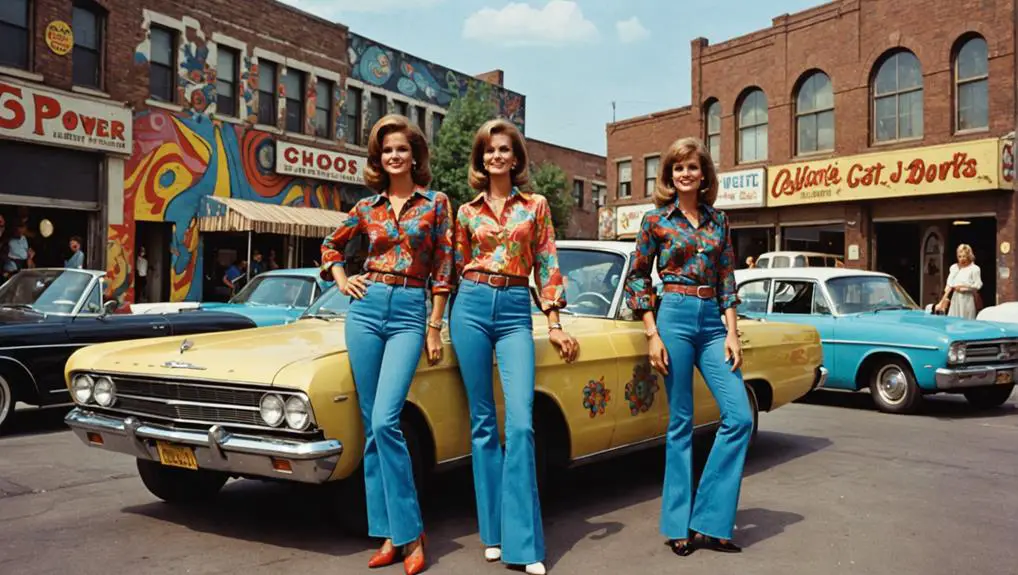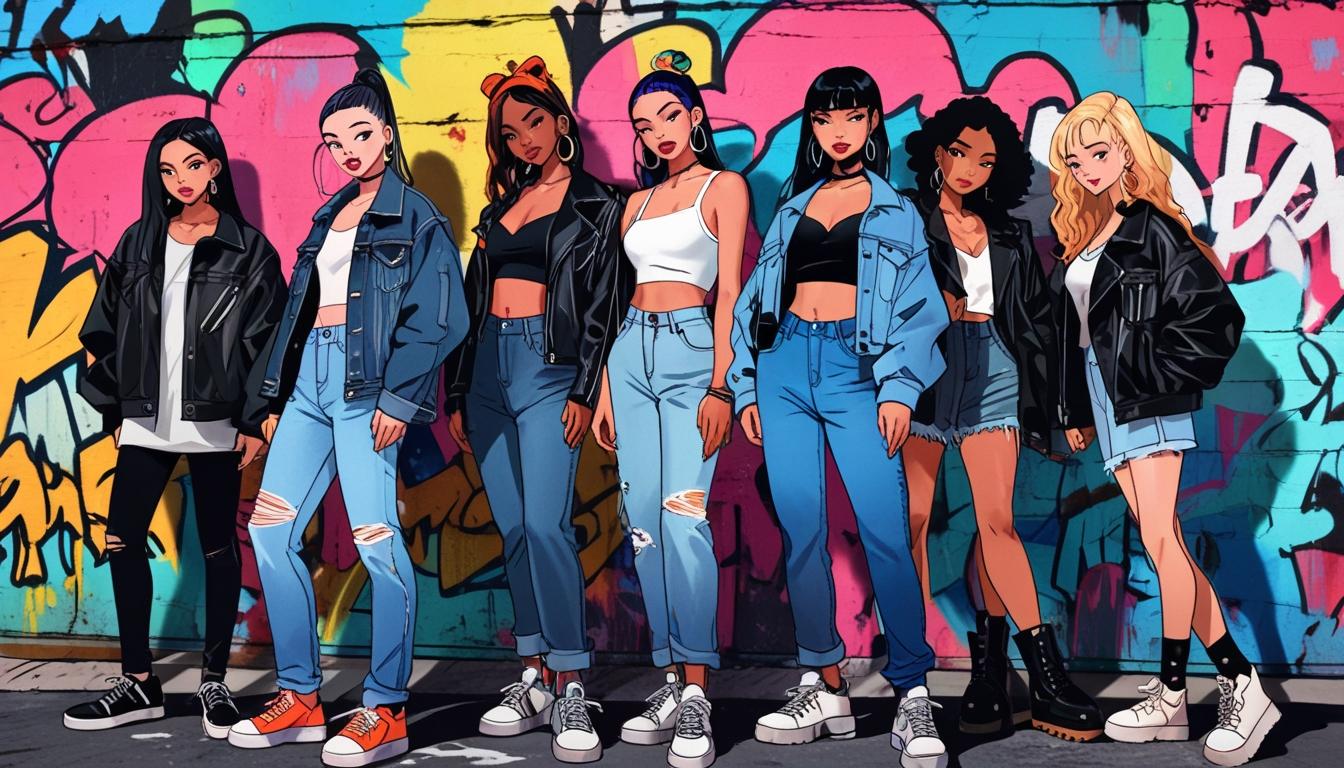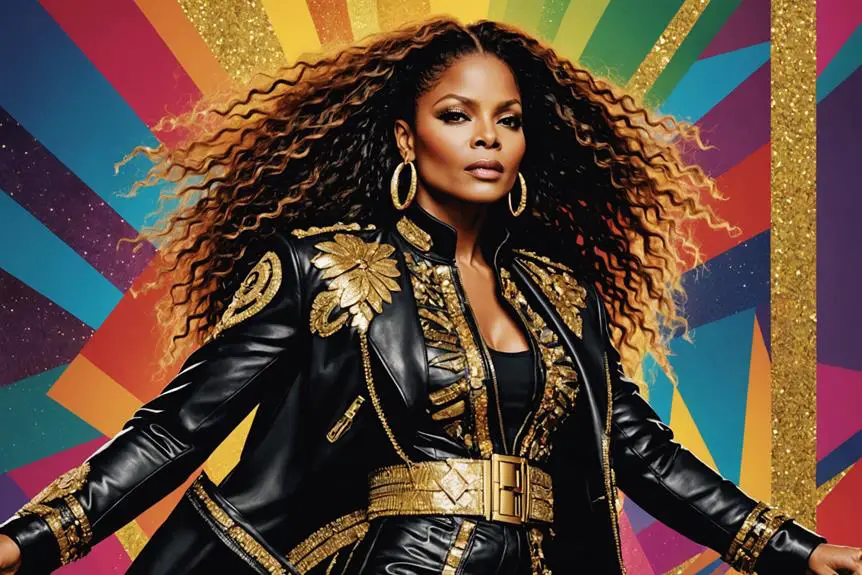In the 1960s, women's jeans transformed into a bold statement of individuality and rebellion. You'd find high-waisted styles, bell bottoms, and even tapered fits capturing the essence of the era's counterculture. Denim, once merely workwear, became a canvas for self-expression, featuring striking colors and daring patterns. Iconic brands like Levi's and Wrangler pioneered these trends, with jeans symbolizing youth culture and solidarity during significant movements. As casual attire blurred lines with professional wear, denim established itself as a versatile staple. There's much more to discover about how these styles shaped fashion and culture during this vibrant decade.
Historical Significance of 1960s Jeans
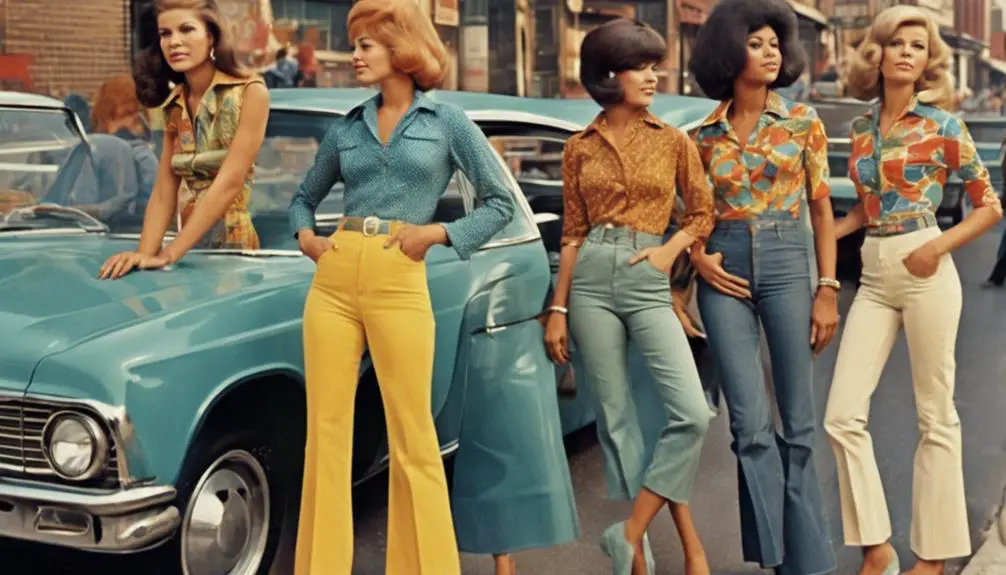
The transformation of women's jeans in the 1960s marks a significant moment in fashion history, signifying a shift in societal norms and gender roles. As jeans evolved from mere workwear to a fashionable staple, they became symbols of liberation for women, allowing you to break free from traditional expectations. High-waisted and bell-bottom styles emerged, reflecting the vibrant counterculture movement, where self-expression and rebellion flourished.
In this era, denim wasn't just a fabric; it became a canvas for individuality. You might've noticed how floral designs and bold colors began to adorn women's jeans, emphasizing the desire for creativity in fashion. Iconic brands like Levi's and Wrangler played vital roles in popularizing these styles, with the Levi's 501 becoming emblematic of youth culture and defiance against societal norms.
Moreover, during significant moments like the civil rights movement, you could see women wearing jeans as an act of solidarity with blue-collar workers, challenging social conventions. The historical significance of 1960s jeans lies in their ability to empower women, marking a transformative period where fashion intersected with politics, personal identity, and collective rebellion.
Evolution of Denim Styles
Throughout the 1960s, women's denim styles underwent a remarkable evolution that mirrored the decade's burgeoning spirit of self-expression and rebellion. You could see this shift in various key trends:
- Change from high-waisted, tapered pants to relaxed fits.
- The rise of bell-bottoms and flares, often in vibrant colors.
- The introduction of hip-hugger styles with wide belts.
- The emergence of the 517™ Boot Cut Jean, blending practicality with style.
As denim became a staple in women's fashion, it transformed from mere workwear to a symbol of youth rebellion. Brands like Levi's played a pivotal role, popularizing these new denim styles that reflected the changing societal norms. Bell-bottoms, gaining traction in the mid-60s, featured dramatic flares starting below the knee, often adorned with psychedelic prints, embodying the era's counter-culture fashion. The late 60s saw hip-hugger styles emerge, marking a significant departure from conservative silhouettes. This evolution in denim not only showcased fashion trends but also highlighted the desire for freedom and individuality, allowing women to express themselves boldly and authentically.
Iconic Brands and Their Impact
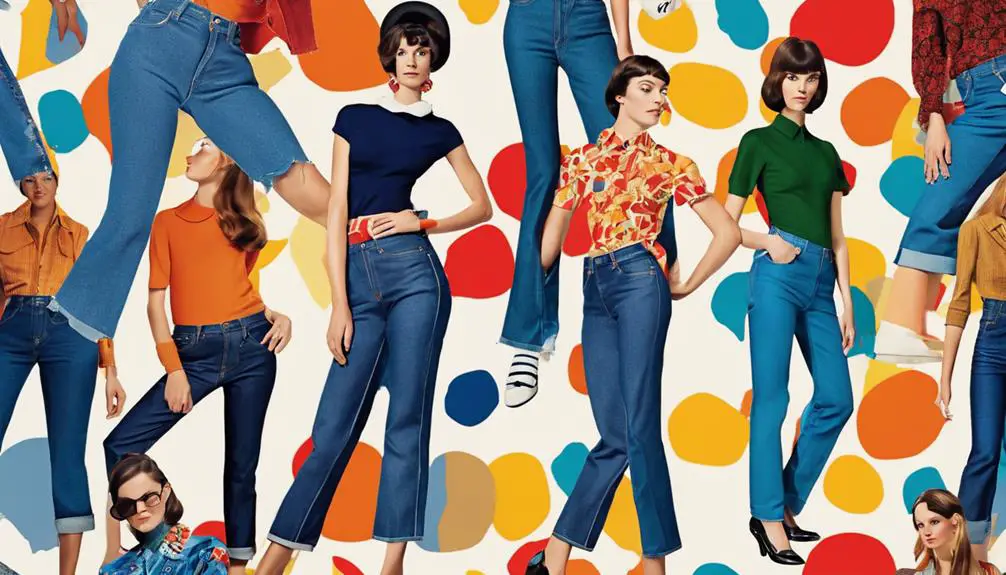
Several iconic brands emerged in the 1960s, each leaving a significant mark on the women's denim landscape. Levi's, Wrangler, and Lee were at the forefront, enhancing the appeal of women's jeans through innovative designs that resonated with the era's rebellious spirit. Levi's 501 jeans, famous for their "Big E" label, became a symbol of durability and style, attracting women who wanted practical yet fashionable pants.
Wrangler distinguished itself with unique styles, such as bell bottom flare jeans and tapered leg options, capturing the youthful energy of 1960s fashion. Their focus on quality American craftsmanship made these jeans a favorite among women seeking both flair and functionality. Meanwhile, Lee's vintage denim gained traction for its comfortable fit, addressing the desire for fashionable clothing during a time of cultural transformation.
The introduction of high-waisted flare leg styles marked a pivotal shift in women's fashion, promoting a more diverse and expressive wardrobe. These iconic brands not only popularized specific styles but also helped establish denim as a staple in women's everyday wear, shaping the future of women's jeans in ways that are still felt today.
Popular Cuts and Fits
Embracing a variety of cuts and fits, women's jeans in the 1960s transformed the fashion landscape, allowing women to express individuality while remaining stylish. The decade showcased distinct styles that catered to diverse tastes and lifestyles. Here are some popular cuts:
- High Waisted: These jeans featured a slim-fitting silhouette, hugging the waist and tapering down toward the ankle for a flattering profile.
- Bell Bottoms: With a fitted upper leg that flared out below the knee, bell-bottoms were inspired by naval uniforms and popularized by the counterculture movement, representing freedom and rebellion.
- Tapered Jeans: Known for their narrow fit through the hips and legs, tapered jeans became a chic alternative to looser styles, often adorned with bold patterns and prints.
- Palazzo Pants: Offering wide-legged designs, palazzo pants provided a dramatic silhouette that was both stylish and comfortable, ideal for the modern woman.
Alongside these styles, denim shorts emerged as a casual staple, with vintage cut-offs and knee-length options reflecting the relaxed fashion trends of the era. These cuts not only defined an era but also allowed women to embrace their unique styles.
Cultural Influence on Fashion
Denim jeans frequently served as a canvas for cultural expression during the 1960s, symbolizing the era's spirit of rebellion and individuality. As you explored the streets, you'd notice how denim became intertwined with the counterculture movement, reflecting a longing for self-expression among the youth. This fabric wasn't just about fashion; it represented a break from traditional norms and a push for freedom.
Political activism prominently featured denim, with figures like Martin Luther King Jr. donning jeans to signify solidarity with the working class. This choice challenged societal conventions while uniting diverse groups under the banner of change. Cultural icons like Bob Dylan and Merle Haggard further solidified denim's place in youth culture, showcasing its versatility and ability to transcend class and gender boundaries.
The "Jeans Revolution" in Eastern Europe highlighted denim's global significance, symbolizing liberation during political unrest. In places like East Berlin, it became a garment of hope and resistance. Ultimately, denim jeans in the 1960s encapsulated a vibrant mix of rebellion, fashion, and political activism, making them a powerful emblem of a transformative era.
High Waisted and Tapered Designs
The 1960s marked a significant evolution in women's fashion, particularly with the rise of high waisted and tapered designs that complemented the era's dynamic spirit. These styles redefined femininity, offering a snug fit that accentuated the waist and created a flattering silhouette. Here are four key aspects of this trend:
- High Waisted Designs: Sitting comfortably at the waist, these jeans enhanced natural curves.
- Tapered Pants: Originally known as cigarette pants, they gradually narrowed from the hips to the ankle.
- Bold Patterns: The vibrant fashion of the 1960s embraced solid colors and striking patterns, making a statement.
- Functional Details: Designs often featured side zippers, adding a unique flair and practicality.
The introduction of brands like Jax slacks in the early '60s made these high waisted and tapered styles accessible at $60 per pair. This shift marked a turning point in vintage fashion, allowing women to embrace both elegance and comfort. The tapered silhouette became a staple of 1960s style, reflecting the era's cultural shifts and the desire for a modern, confident aesthetic.
The Rise of Bell Bottoms
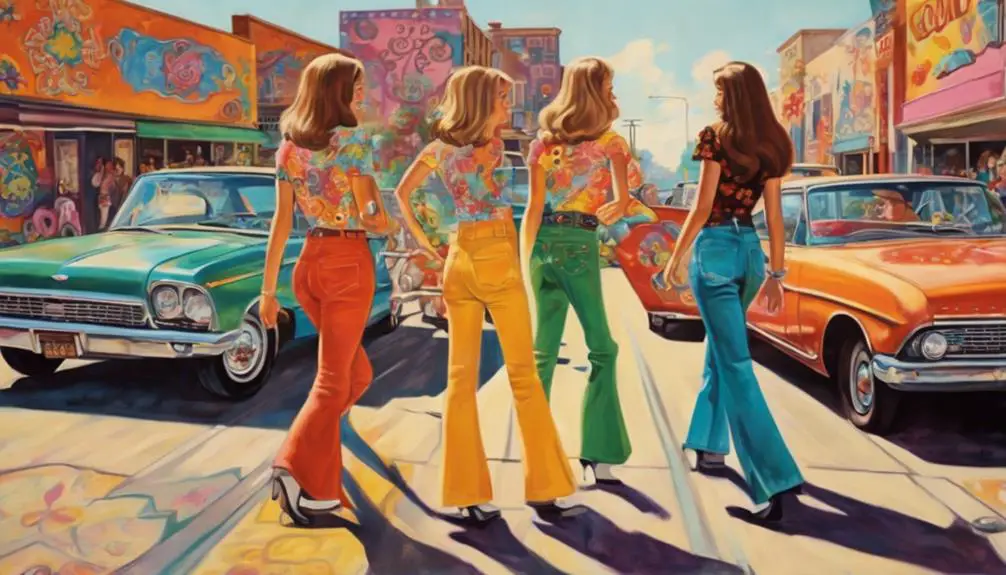
In the early 1960s, a fresh wave of style emerged with bell bottoms, capturing the imagination of young fashion enthusiasts. These jeans, characterized by a fitted waist and dramatic flare from the knee down, quickly gained popularity among the youth. Initially inspired by sailors' pants, bell bottoms featured vibrant colors and patterns that resonated with the counterculture movements of the time, making them a symbol of individuality and freedom.
By 1966, bell bottoms became a mainstream fashion staple, particularly associated with the burgeoning hippie movement. You'd notice these jeans not just for their wide leg openings but also for the creativity people expressed through modifications. The introduction of the iconic 646 Bell Bottom jeans by Levi's in 1969 marked a turning point; their flattering fit and comfortable pre-shrunk cotton captured the essence of 1960s fashion.
As bell bottoms evolved into the 1970s, they incorporated elements like zippers and belts, further solidifying their place in your wardrobe. This flair for style not only transformed how women wore jeans but also influenced broader trends, symbolizing a cultural shift towards self-expression and liberation.
Casual Vs. Professional Attire
As bell bottoms and other denim styles became symbols of youth culture in the 1960s, the fashion landscape experienced a significant shift in how women approached casual and professional attire. Vintage clothing from this era often displayed unique designs and craftsmanship, with vintage clothing labels providing essential insights into the brands and styles of the time. You might notice these key trends that define this era:
- High-waisted cigarette pants: Slim-fitting and cropped to ankle length, they showcased footwear while embracing vibrant prints.
- Denim jeans: Styles like bell-bottoms and hip-huggers became the go-to casual wear, symbolizing rebellion.
- Women's pantsuits: Matching tapered pants and blazers emerged, enabling women to challenge traditional gender norms in the workplace.
- Versatile jumpsuits: Often crafted with rich fabrics and wide leg designs, they blurred the lines between casual and formal attire.
This evolution reflects a broader cultural shift. While professional attire remained tailored and conservative, pants became increasingly accepted in workplace settings. As denim jeans gained popularity, they began to infiltrate professional attire, paving the way for future generations to embrace casual wear in business environments. The contrast between casual styles and professional attire defined women's fashion in the 1960s, illustrating a significant transformation in societal expectations and personal expression.
Vintage Preservation and Modern Trends

With a growing appreciation for vintage fashion, collectors and enthusiasts alike are drawn to the unique charm of 1960s denim, which reflects a vibrant era of self-expression and societal change. Styles like high-waisted and bell-bottom jeans embody the counter-culture ideals of the time, making them highly sought after today. Understanding the significance of vintage tag identification can greatly enhance your ability to identify rare and collectible items, thereby enriching your collection. As you explore vintage denim, understanding preservation techniques becomes essential; proper storage—avoiding direct sunlight and high humidity—ensures the fabric's integrity and longevity.
In today's market, modern trends often reinterpret these iconic styles. You'll find contemporary brands releasing collections featuring high-waisted cuts and flared legs that pay homage to the original designs while adding unique embellishments. This resurgence of interest has spurred a growing market for authentic 1960s jeans, with prices varying based on brand, condition, and rarity, sometimes reaching several hundred dollars.
Educational resources and communities now offer guidance on vintage tag identification and styling these timeless pieces in contemporary outfits. By blending the old with the new, you can appreciate the rich history of 1960s fashion while expressing your unique style in a modern context.
Frequently Asked Questions
What Jeans Were Popular in the 60s?
In the 60s, you'd see high-waisted jeans, bell-bottoms, and tapered styles dominating the scene. Each offered distinct fits and flair, reflecting the era's vibrant spirit, youthful rebellion, and evolving fashion landscape that defined casual wear.
Did People Wear Flared Jeans in the 60s?
Yes, you saw people embracing flared jeans in the 60s. With their fitted waists and dramatic flares, they became symbols of rebellion, self-expression, and a vibrant youth culture, reflecting the era's evolving fashion trends and social movements.
Were Ripped Jeans a Thing in the 60s?
Ripped jeans weren't mainstream in the 60s. While some individuals modified jeans, intentional ripping didn't gain traction until later. The decade focused more on colorful designs and styles reflecting the vibrant counterculture movements.
Did People Wear Skinny Jeans in the 60s?
You won't find skinny jeans in the 60s. Instead, people sported high-waisted, tapered pants, embracing a silhouette that flared at the ankles. The skinny style only gained traction later, influenced by evolving fashion trends.
